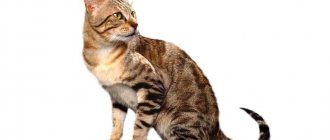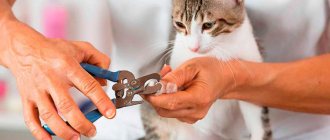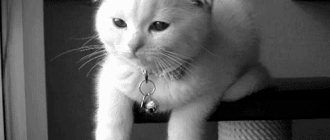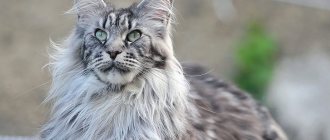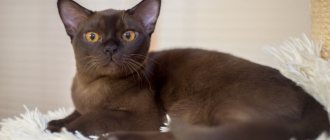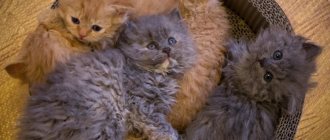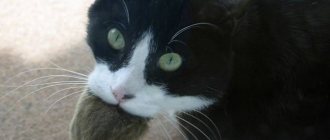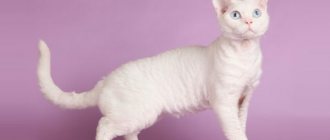Savannah is a cat breed planned by American breeders. This means that it appeared thanks to the deliberate work of breeders, and not, like most known breeds, as a result of a random mutation. Despite the fact that savannah appeared about thirty years ago, its popularity reached its peak in a very short period and exceeded the expectations of its creators.
Savannah is a tall, cheetah-colored beauty who has captured the hearts of connoisseurs of exotic breeds. It mixed the genes of a Bengal cat and an African serval, thanks to which the cat received a bright appearance and a fiery temperament. In this article we will tell you what the Savannah is like in the world of cats, what the breed standard is, what to look for when buying a kitten, how to raise, what to feed the animal, and how to care for it.
History of the origin of the Savannah cat breed
In 1986, breeder Judy Frank decided to experiment and organized a “wedding” of a serval with a Siamese cat. At that time, the resident of the Pennsylvania outback was already breeding bush cats, so she already had some experience in this area. The Siamese’s “groom” was a male serval who lived with Judy’s friend, Susie Woods.
The kitten liked the impressive cat, and Frank’s idea came to life: the couple gave birth to two long-legged kittens with a spotted coat. Judy gave the cat to the Serval owner, and three years later she gave birth to spotted babies after mating with an Angora cat. Susie Woods named the baby Savannah, made several “expert” publications on the topic, and applied for official registration of the breed.
The main contribution to the development of the breed was made by breeder Patrick Kelly, who purchased a kitten from Susie Woods and enlisted the support of Bengal breeder Joyce Sroufe. In 1996, Kelly and Sroufe introduced a new breed of cat with a unique cheetah-like pattern called the Savannah.
In 2001, the breed was registered in several felinological associations, and Joyce Sroufe gained worldwide popularity.
A sensational scandal
In 2007, an American biotechnological company announced the development of a completely new breed of Asher.
The head of the company was Simon Brody. Three types of felines participated in the creation of the breed: the African Serval, the Bengal cat and the domestic cat.
A little later, after the breed made a splash, a certain Chris Shirka from Pennsylvania filed a fraud claim. Chris raised the Savannah breed. From Asher's photograph, he realized that these were kittens purchased from him. The accusation was confirmed following DNA results. As it turned out, Ashera is an invented breed under which Savannahs were sold for a lot of money (the price could reach a million rubles).
Chris Shirk recognized his kittens from a photo
A criminal case was opened against the fraudster, and Brody himself was on the run.
However, ushers are still popular among buyers, despite the revealed deception and enormous cost.
The name of the breed was given in honor of the West Semitic goddess of fertility. And the breed is called the Savannah Asher.
Description and breed standards
Not all cat lovers know who Savannahs are and what they look like, so we have prepared for you a detailed description of the breed standard. Once you look at the cat, you will know that it is a savannah.
Savannah is a large cat, about 1 m long and weighing 15 kg. The length of her jump reaches 3 m! The animal's head is wedge-shaped, small in size, slightly elongated. Cheeks and cheekbones are expressionless. The stop is almost straight.
The nose and earlobe are large, the bridge of the nose is wide. Black cats have a black lobe, while tabbies have red, brown, and a pink-red stripe running down the center.
The eyes are large, expressive, obliquely set, almond-shaped. There are dark teardrop-shaped marks in the corners of the eyes. The iris is golden, amber, emerald, deep green.
The ears are large and close set. The tips are rounded. The inner part of the ear is pubescent, covered with light markings.
The neck is long, not wide, graceful.
The physique is athletic, muscles are developed, the chest is wide. The pelvis is narrower than the shoulders.
The limbs are long, strong and muscular. Hips and shoulders elongated. The paws are powerful, oval. Fingers and claws are large.
The tail is thick, of medium length, reaching the hock joints, tapering closer to the tip.
The coat is short, the undercoat is dense and at the same time soft, pleasant to the touch. The guard hairs are hard, but in places of dark spots they are soft.
Colors:
- brown tabby spotted;
- black smoky;
- black spotted;
- silver spotted;
- golden;
- brown.
The standard colors of spots are brown, dark brown, black. The shape is oval, the contours are clear. The spots are small on the chest, limbs and head, and large on the back. Contrasting parallel stripes stretch from the back of the head to the shoulder blades.
The appearance of the savannah is influenced by the generation to which the animal belongs: F1 hybrids are similar to servals and are large in size, F2 hybrids are much smaller than the first generation.
Hybrid levels look like this:
- F1 - descendants of a serval and a domestic cat (50/50% genes).
- F2 - descendants of an F1 female and a domestic cat (23% of genes).
- F3 - descendants of an F2 cat and a domestic cat (13% of genes).
- F4, F5 - the descendants of a hybrid of F3 and an ordinary cat are no different from ordinary domestic cats. The wild essence is revealed by the leopard color and behavior atypical for domestic cats.
Aggressive cats with behavioral disorders, polydactyly, those who try to bite a person, or, on the contrary, cowardly cats are subject to disqualification. Individuals with “medallions” and rosette spots on the chest, as well as animals with small ears, are discarded.
Colors
The standard allows 4 colors:
- Silver spotted.
- Black.
- Black smoky.
- Brownie tabby spotted.
The spots on the skin are black or dark brown. There should be contrasting stripes on the back (from the back of the head to the shoulder blades).
In the photo there are Savannah breed windows of popular colors: silver spotted, black smoky, brown tabby spotted
Character
The Savannah cat is friendly, strongly attached to people and infinitely loyal. She prefers an active lifestyle and despises idle time on the couch. That is why it is not suitable for people who consider a cat solely as a living interior decoration. Nature has rewarded her with extraordinary mental abilities, thanks to which learning various tricks and commands is easy and relaxed.
Savannah tends to be dominant. She inherited this character trait from the serval, but this feature is neutralized by castration or sterilization. After the procedure, the animal becomes calm and patient, reacts less to external stimuli, but leadership habits still periodically appear in F1 and F2 hybrids. Such pets should be kept in spacious enclosures, but the owner must constantly communicate with the animals. For families with children, representatives of the breed with a more docile character - F3-F4 hybrids - are suitable.
Savannah cannot be left alone for a long time - they will turn the house into ruins with great pleasure. Damaged furniture, tattered walls, overturned flower pots - this is just a small part of what offended cats can do. Another unpleasant character trait of Savannahs is resentment. The animal will definitely take revenge for the disrespectful attitude at the most unexpected moment.
F1 hybrids are not kind to strangers. They greet uninvited guests with an aggressive hiss and loud grunt. Representatives of each subsequent generation are more supportive of strangers, but will not let them get close to themselves.
Reference. Savannahs get along with cats and dogs without problems only in one case - if they grew up together.
Feeding
This breed of cat is essentially a hunter, and therefore they eat food that has a lot of protein, a little less fat and a very small amount of carbohydrates. In addition to the basic substances, cats should consume vitamins, amino acids, minerals and other useful components. Their body digests food with a high moisture content.
It is best to eat a balanced diet based on home-cooked meals. A raw diet is key. The best choice is raw meat or fish. Portion size is very important. Savannah cats are larger than ordinary cats, very active, and therefore they need more food and water. An adult cat can eat a kilogram of meat per day.
The best food for the savannah is raw meat.
If it is not possible to buy raw meat every day, you can give canned food, but not dry food. Prepared food, of course, works better as a supplement.
A raw diet is the best for savannahs. Kittens are fed 2 times a day, up to about two (the breed takes a long time to grow) in the amount they want. Adults eat 3-6% of their body weight or more. Depends on how much energy the cat uses per day.
Maintenance and care
Before starting a Savannah, the owner must understand that he will have to walk, communicate, not pay attention to broken vases and damaged wallpaper, and put up with an independent character. These domestic cheetahs are real jumpers. They love to climb on cabinets, ride on doors, and watch from above what is happening below. Savannah breeders recommend hiding any fragile or small items if you want to keep them safe. You can wean your cat off the habit of jumping where it shouldn’t by using an electric mat. Spread it on the closet that the cat has chosen for himself.
Be sure to buy a scratching post, otherwise the furniture upholstery, flooring and walls will turn into shreds. Choose durable, well-made fixtures.
Cover the trash can with lids if you don’t want your cat to scatter its contents throughout the apartment. Rummaging through trash is a favorite pastime of the savannah.
Grooming is not burdensome; it is enough to brush the cat once a week in the off-season, and daily during the period of active shedding. Instead of a brush, you can use a damp cloth, which perfectly collects dead hair.
Nail trimming is included in the list of mandatory procedures. In some cases, laser declawing of the front paws is performed. Savannahs are not afraid of water and enjoy swimming in baths and pools.
Cats get used to the litter box quickly. For F4 and F5 hybrids, a regular medium-sized tray will do. In addition, cats go outside to relieve themselves without any problems and easily master the intricacies of going to the toilet.
Savannah food
The diet of the savannah is in many ways similar to that of the African serval. Cats prefer lean meat (turkey, chicken, rabbit or veal), and do not refuse fresh tuna or salmon. It is better not to give river fish. Whole milk and table food are also prohibited. Cats on natural food must be provided with additional vitamins and minerals.
Experienced breeders advise feeding savannahs with high-quality dry food with a maximum content of animal proteins and a minimum content of grains. With this diet, the animal receives a daily portion of vital components.
Health and life expectancy
Savannah has excellent health, her life expectancy is 18-20 years. Representatives of the breed are occasionally diagnosed with: polydactyly, hydrocephalus, dwarfism and cleft palate. Cats with reduced immunity suffer from viral bacterial and fungal infections. If the animal refuses to eat, loses hair, or becomes lethargic, contact your veterinarian to identify the causes of this condition. Don’t forget about mandatory age-related vaccinations.
Upbringing
Savannah's health and muscle tone can be maintained by regular walks and exercise. From an early age, the pet is taught to walk on a leash, especially F1 hybrids, which are difficult to train. It is better to keep representatives of the first two generations of savannas in a specially equipped enclosure, where they can walk freely at any time of the day.
There are no problems with training domestic cheetahs. Thanks to their natural intelligence and high intelligence, these cats grasp commands on the fly. Savannahs are even able to master dog commands - for example, “Fetch!”
Savannahs are endowed with an innate hunting instinct, which they often demonstrate towards their owner. Under no circumstances allow the kitten to play with your hand - such games with an adult cat will end in stitches. Regularly walk with your pet in the fresh air, play games, give feasible physical activity, buy toys in the form of mice, hamsters and other small animals that the savannah can “hunt”.
Breeding
Savannah males of the F1-F4 generation are sterile and are still subject to castration.
F5 males are capable of reproducing offspring, so they are bred with other purebred cats: Bengals, Ocicats, Egyptian Mau.
Animals reach maturity at the age of 1.5-2 years.
Diseases
When you look at these lean, energetic creatures, it seems that diseases avoid them. This is partly true: savannahs retain mobility and flexibility of joints, animal instincts and a sharp mind until a very old age. Their excellent immunity allows them to quickly cope with fungal and viral infections and heal wounds. But sometimes representatives of this breed also have defects.
One of the most common is the “cleft palate” - a cleft palate. This can only be dealt with surgically. Sometimes kittens are diagnosed with hydrocephalus or dwarfism. But such cases are so rare that they are the exception, not the rule.
Savannahs, like other cats, should be up to date on vaccinations against rabies and other dangerous diseases, as well as given anti-worm medications.
Individuals of classes F1, F2, F3 and F4 are sterile, but F5 males are allowed to mate with other cats (it is not prohibited to breed a cat with ordinary outbreds, but breeders prefer Egyptian Mau, Ocicat and Bengal).
How to choose a kitten
Before purchasing a Savannah kitten, be sure to research all known nurseries that breed. Ask the breeder to provide comprehensive information about the cats, show pedigree, vaccination passport, genetic tests, diagnostic results.
Physically and psychologically healthy kittens behave calmly, kindly and adequately, do not hiss or scratch. However, for F1 individuals such behavior is the norm. Many nurseries transfer kittens to permanent families from 3-4 months. At this age, babies are already accustomed to the tray, have all the age-appropriate vaccinations and have been tested for hidden infections.
Five reasons to buy a kitten in our nursery
1. We almost always have kittens in stock that you can purchase;
2. Since they are all born in our nursery, we can offer lower prices;
3. If you wish, you can order a kitten for yourself from different manufacturers, having previously visited our nursery;
4. We keep grown cats of all breeds so that you can see what your pets will become in the future;
5. We do not try to deceive customers for the sake of sales at any cost.
Buy a Savannah F1 kitten
Advantages and disadvantages of the breed
The Savannah cat breed has a number of advantages:
- extravagant appearance;
- extraordinary mental abilities;
- devotion;
- friendliness;
- ability to learn quickly;
- excellent health;
- ease of care.
As for the disadvantages, there are not so many of them:
- high price;
- indomitable energy;
- rancor.
Experts do not recommend keeping F1 and F2 hybrids in families with children.
Horoscope compatibility
Some people who decide to buy a Savannah are interested not only in photos of the breed and reviews about it, but also whether it has qualities suitable for their own character. Zooastrologers believe that the savannah is most suitable for the energetic, purposeful Aries, friendly, intellectually developed Gemini, shy, affectionate Virgo and confident, freedom-loving Sagittarius. But with proper socialization, the Savannah can become a loving, loyal friend for each of the zodiac signs.
Savannah is a unique cat, combining the features of an agile African predator and an affectionate pet, devoted to its owner. Majestic beauty, intelligence, and good character make her the most desirable pet among the cat family.
